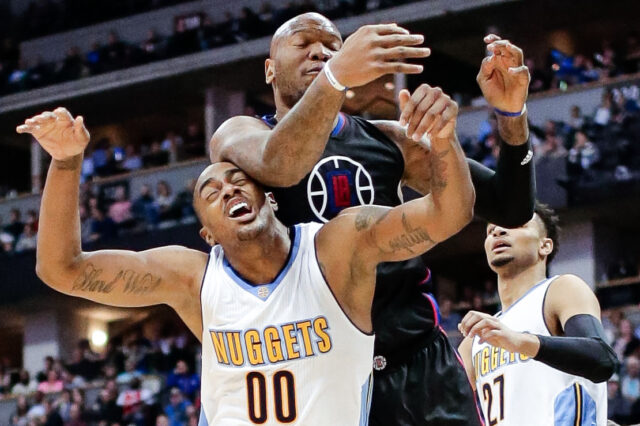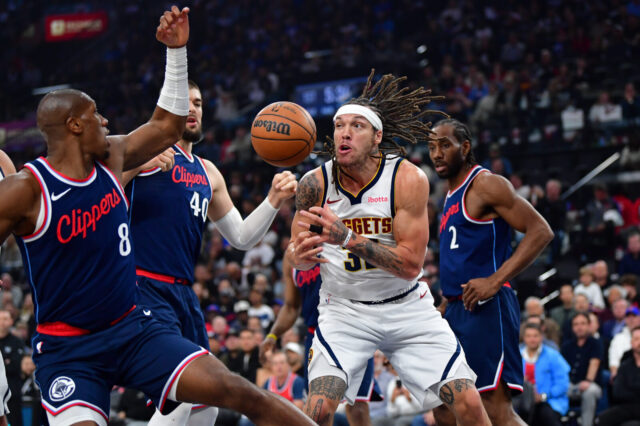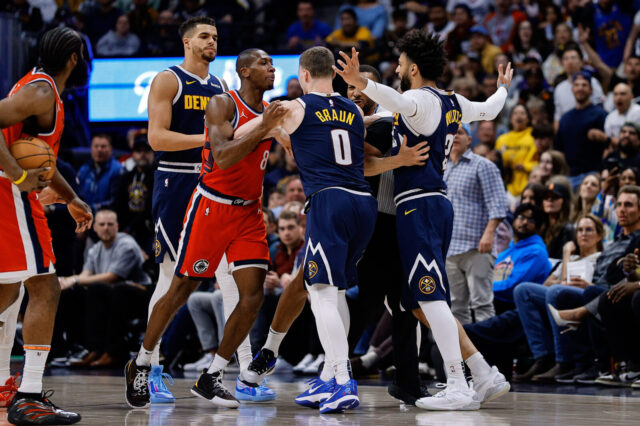The Jerami Grant trade surprised everybody, even though it shouldn’t have.
Before the trade, the Denver Nuggets were sitting roughly $12.5 million below the luxury tax line with limited ability to improve the roster. The only major avenues toward roster improvement were the full mid-level exception (an option for teams over the salary cap to use in free agency when upgrading their roster worth roughly $9.2 million this season) and the traded player exceptions created from last offseason’s money saving moves including the trades of Kenneth Faried, Darrell Arthur, and Wilson Chandler. These are monetary amounts used when performing trades that can help Denver trade for somebody without taking any salary back.
The Oklahoma City Thunder, fresh off of a surprise move trading Paul George to the Los Angeles Clippers for a bounty of future assets, are quickly pivoting toward a rebuild. With a large tax bill pending for a team that had no chance to compete for a championship without George, the Thunder were looking for a quick way to cut salary. The Nuggets, armed with a trade exception and a 2020 first round pick, used those two assets to acquire power forward Jerami Grant, a capable starter to boost their roster while helping Oklahoma City cut costs in the process.
Grant is a starting caliber power forward with the skills to elevate Denver’s roster. While he will likely start off as the bench power forward, Grant’s ability to shoot from the perimeter (39% from three-point range with Oklahoma City in 2018-19) will pair well with the second unit. The Nuggets utilized Trey Lyles as the backup power forward for the first half of last season, and Lyles shot 25% from 3 on the year. He wasn’t a great fit with the backup unit and didn’t display the level of defense that Grant is capable of playing. No matter what, Grant is an upgrade on Denver’s roster, whether he starts or backs up Paul Millsap.
The unfortunate reality of using a trade exception: the Nuggets didn’t send any players back to Oklahoma City, meaning a crowded roster just added another player who averaged nearly 33 minutes per game last season. Grant will play more than Trey Lyles did, and it’s becoming more difficult to identify a healthy rotation for every player on the roster.
Right now, it would seem that the Nuggets have eight players locked into rotation minutes:
- The newly extended Jamal Murray
- Monte Morris
- Gary Harris
- Malik Beasley
- Paul Millsap
- Jerami Grant
- Nikola Jokic
- Mason Plumlee
Notice the lack of true small forwards in the above rotation? II expect Will Barton to reprise his role as starting small forward next season, but it’s unsafe to guarantee those minutes. Torrey Craig finished the playoffs as the starting small forward, displaying a more accurate shooting touch and strong defensive acumen to cover for the weaknesses of Murray defensively. Both players have a claim as the starter.
Two other players also have claims. Michael Porter Jr. has yet to see the floor, but internally (and somewhat externally) the Nuggets are struggling to contain their excitement in watching the rookie perform behind the scenes. At 6’10 (maybe taller) and with an elite perimeter shooting touch, Porter brings a star dynamic that no other forward on the roster can match.
Except possibly the other option here: Juancho Hernangomez. He’s rarely talked about as having a claim for a starting spot, but the Spaniard averaged 11.2 points and 6.3 rebounds in over 30 minutes per game starting at small forward for 25 games last season. Those are really good numbers. He sustained a core injury that needed surgery in the offseason, but he shot 42.5% from three-point range as a starter, playing expertly next to Nikola Jokic before his season fell apart.
All four players have a claim, but only two will consistently play. It’s up to Michael Malone and the Nuggets organization to determine who gives Denver the best chance to win every night.
The other two players left unmentioned are Jarred Vanderbilt and the unsigned second round draft pick Bol Bol. With the addition of Grant to the roster, I don’t expect Vanderbilt to play very often this year. He’s behind everybody else in the rotation pecking order at the moment. Bol was always a developmental signing, and he will probably ride the bench until he’s both physically and mentally ready to contribute at the next level.
That’s 14 total players on the 15-man roster, meaning one spot remains open. Looking at Denver’s roster holes, the logical opening comes at point guard, where the Nuggets are susceptible to a Murray or Morris injury during the regular season and the playoffs. Morris’ skill set is particularly difficult to replicate because of how much he does to facilitate the second unit’s success. Barton can certainly slide into an emergency point guard role, but if Barton is the starter at small forward, using him in the wake of a point guard injury would displace two players in the rotation. It wouldn’t surprise me if Denver’s 15th man was a veteran point guard.
I would be shocked if Denver decided to NOT sign 2017 second round draft pick Vlatko Cancar to a contract. After spending two years playing international ball, Cancar has developed into one of the best young players in Spain. As a forward, it’s difficult to see where Cancar fits into the roster equation, but he’s a competent piece and clearly an NBA caliber player. He fits onto Denver’s roster as someone who wouldn’t play immediately but could in the event of future transactions or injuries.
The Nuggets probably aren’t done making roster moves. With a number of competent pieces in line to sit the bench and question marks at small forward, there are moves that could help clear up the roster and shape it like a true championship contender. Additional perimeter defense is probably required, and identifying a way to match up with the new Los Angeles Clippers tandem of Kawhi Leonard and Paul George will be key for Denver’s upcoming season. The Nuggets still struggle matching up with the James Harden-Clint Capela pick and roll. LeBron James and Anthony Davis play on the same team.
In addition, Denver had four players suit up for 80 games last season, including Nikola Jokic. The Nuggets did a great job of keeping Jokic’s total minutes down, but given the trend of rest and load management for superstars, Denver would be wise to follow suit and give Jokic the occasional maintenance day to keep his body fresh. In addition, Gary Harris has sustained frequent injuries during the last several seasons, and Denver would be wise to put him on a maintenance schedule to keep him healthy and ready for playoff time.
With so many options on the roster, the Nuggets have the ability to start Malik Beasley or Juancho Hernangomez here or there. If those guys factor into the future plans, then it would be wise to keep them integrated in the rotation and not have minutes drasticall reduced. If the Nuggets know they can’t afford all of the young guys in the future, I could see them exploring trade options for those two (along with Torrey Craig) as players on expiring contracts that can’t prove their full value in a crowded Denver rotation.
The Nuggets have long been ripe for a consolidation trade, and the piece that makes the most sense is Bradley Beal, a star caliber player on a team that is stuck in the mud. The exact package remains to be seen, but if the Nuggets are still looking to make a splash, monitor Beal and the Wizards closely.
It’s unclear the Nuggets have the juice to compete with other top teams a year after losing to the Portland Trail Blazers in the second round of the playoffs last year. Does a rotation with extreme depth make up for the lack of a true second star next to Nikola Jokic? Do the Nuggets firmly believe in Murray or Porter filling that position soon? Keeping an eye on Connelly and the Nuggets front office is a good way to find out which direction the Nuggets will soon go. The Grant trade was a major step, but whether it was THE step to help the Nuggets win a championship remains to be seen.


